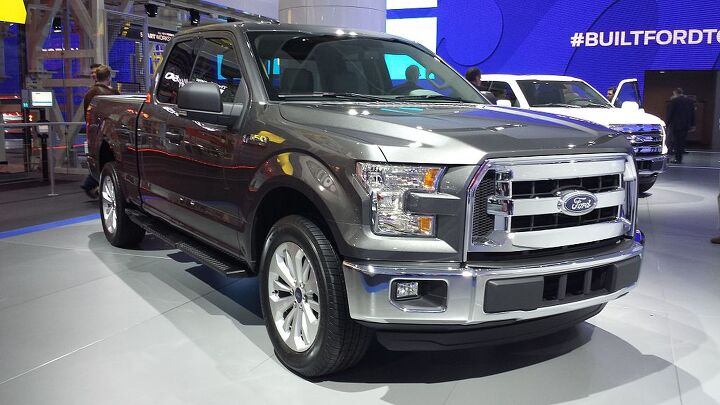Question Of The Day: Is SFE The Key To MPG?
When we published the 2015 Ford F-150 order guide, we focused on the trim level changes (the FX4 and STX trims are gone, while the police-oriented SSV package is back) while forgetting three very important letters. SFE.
On other Ford models, the SFE package is used to denote a high fuel economy trim – think the 1.0L Fiesta Ecoboost. As The Motley Fool’s John Rosevar found out, the volume XL and XLT trims of the F-150 will have an SFE package with smaller 17″ wheels, a special tonneau cover and the new 2.7L Ecoboost engine. The SFE trim will only be available in regular or SuperCab configurations, not the popular crewcab style.
Depending on how you look at it, Ford has two targets to hit. The Ram 1500 HFE, which is a V6 model with active grille shutters, start-stop and other technologies that provide incremental gains in fuel economy, can hit 25 mpg on the highway. The Ram 1500 EcoDiesel, which uses a diesel V6 engine, can get as much as 28 mpg.
If I were to place a bet, I’d say that Ford will go for broke and try to at least match the EcoDiesel. That would give their much-touted aluminum truck the em-pee-gee bragging rights in the entire segment. And from there, it’s only a matter of time before the 30 MPG truck arrives.
More by Derek Kreindler


































Comments
Join the conversation
10 speed transmissions. 30 MPG full size trucks. The future is now.
The key to Fords MPG in the 2015 F150 is the flexibility of the CGI based 2.7 v6 EcoBoost engine!! The can easily increase the Compression Ratio to 15:1 and more like a Diesel n get great low end torque like 375 ft lbs and efficiency without high turbo boost and use advanced engine controls to avoid knock...! This is their secret weapon... A great gas engine that really performs like a diesel snd its Less Than $500 upgrade!!!!! That's is the Game Changer!!!! RIP Ram EcoDiesel...!!!
Here's a data point: a couple of years ago pickuptrucks.com did a comparo of a bunch of 1/2 ton pickups, including a drive loop in central Michigan pulling an 8000 lb. trailer. They used multiple drivers for each truck to try and minimize the effect of different driving styles. On that loop, the F-150 Ecoboost achieved a fraction over 10 mpg. The then-new Chevy/GMC twins with the new 5.3 liter DI 8 cylinder, achieved a bit over 12. These engines are rated at something like 5 hp less than the Ecoboost. The point being that turbocharged engines loaded up seem to be fuel-suckers. If your use of a pickup is essentially like a car, I suppose this doesn't matter. But if you plan to use its carrying or towing capacity, then it matters a lot. Diesel engines generally seem to suffer a lesser fuel economy hit under load than even normally aspirated gasoline engines; perhaps because gasoline engines are forced to spin at higher rpms to develop their power. Turbocharging would seem to be the answer, except for the fact that the extreme cylinder pressures associated with forced induction apparently require a rich mixture to keep things from getting crazy. Bottom line, if Ford claims to have a turbocharged version of the F-150 that gets the same highway mileage as the diesel RAM 1500, I'd take the diesel in a second, if real world fuel economy were important to me.
I'm sorry, at 5000 lbs, with a large frontal area and a box in the back, Ford is NOT going to get 30mpg at 65-70 in real life, now or ever. I coaxed 20mpg from a 2008 Chevy Silverado 5.3 V8 ext cab 4wd averaging 63 mph, with everyone passing me. It had cylinder deactivation too. It weighed 5600 lbs, I think. My 2011 Malibu is good for 32-34 mpg at around 70 mph. It is much more aerodynamic than a truck, much smaller frontal area, with 2.4 liter 4 cyl doing about 2200 rpm at 70. Unless there is some radical change, most all of the "accessible" waste in the internal combustion engine has been squeezed out. Unless one of the car makers is willing to go back to 1979, when a base 2wd pick-up with an IRON engine weighed around 4000 lbs, and was lower to the ground (infintely more practical), where the body and frame were less stiff (but still robust enough to carry a load and last for decades), 30 mpg highway in a 'full-size' truck ain't gonna happen.